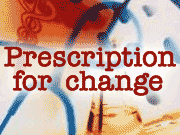 |
| Doug Campbell, and his wife Jane are embracing consumer-driven health care for themselves and their children, Owen and Dalton. (MPR Photo/Annie Baxter) |
Bloomington, Minn. — When researchers talk about how Americans overuse the health care system, they're probably not talking about the Campbell family. Doug and Jane Campbell, both in their early 40s, are trim and athletic. Doug says he's never been big on doctor visits and prefers to cultivate wellness rather than treat illness. So the Campbells are teaching their kids good fitness habits. Their youngest son Owen is six and plays field hockey and basketball. Their eight-year-old son, Dalton, has his own routine -- karate.
The Campbells live in Bloomington. Doug works in information technology at a life insurance company and Jane's a school teacher.
A couple years ago, they started thinking about enrolling in a new health plan Doug's employer offered through UnitedHealth Group. It was a Definity Health HRA, or health reimbursement account, the cousin of another plan that's becoming popular called an HSA or health savings account.
Here's how the HRA that the Campbells were considering works: Doug's employer would provide $1,500 a year for the family's health coverage. The Campbells would have to manage that sum like an allowance, keeping track of their balance throughout the year. Preventive care doctor visits would be fully covered. But for any other kinds of health care, the family would have to pay for the doctor visits out of pocket, and then they'd get reimbursed for their expenses with the money furnished by Doug's employer.
The plan appealed to the Campbells for two big reasons. First, their monthly premium would cost $30 a month less than a more traditional plan. And second, Doug Campbell admired the philosophy behind the new consumer-driven plan. It's based on the premise that consumers will be less wasteful of their health care dollars if they're more involved in managing the money.
"It's one of the only innovations that have come along in a while, as far as something new and better," he says. "Let's give a try, see if it works."
So they signed up for the plan. Initially, Jane Campbell was less enthusiastic about than her husband. She feared the kids would get sick unexpectedly and the family would blow through the $1,500 provided by Doug's employer. If that happened, they'd have to pay the next $1,000 in health care costs before insurance kicked in to pick up the rest. Jane worried she'd skimp on doctor visits to avoid that happening.
"As a parent, you can't watch your child be miserable, so if they didn't feel well, I wanted to bring them in, and I didn't want to worry about it being the tenth time. But luckily, our kids are pretty healthy, and we haven't gone much other than the well check-ups," she says.
CONSUMER: MEET THE PRICE OF YOUR HEALTH CARE
Consumer-driven health care plans are structured to better acquaint consumers with the price of health care. Ostensibly, when consumers see how much doctor visits cost and are accountable for those expenses up front, they're more prudent in their health-care spending.
And the plans offer consumers an incentive for using their health care dollars wisely. For example, if the Campbells don't spend all of the $1,500 they get from Doug's employer in their health reimbursement account, the remaining money rolls over from year to year. The Campbells started out 2005 with a $700 surplus from the previous year that provided an extra cushion for their health spending.
Jane Campbell says she's actually come to derive a certain satisfaction from managing their health care account. For Doug, that's proof their experiment with an HRA has been worthwhile.
"I think it's kind of interesting that Jane, who was reluctant at first, now kind of keeps a running tally," he says. "And it becomes fun and kind of a little of a game to find out where we're at through the year, if we can carry over a big pile of money into next year."
The Campbells are part of a small group of Americans who are signing on to consumer driven health care plans. According to a study by the Kaiser Family Foundation, about two million people have adopted plans like HRAs and HSAs through their employers. Advocates of consumer-driven health care say that number indicates a burgeoning movement. Critics say it's too early to gauge it that way for sure.
In any case, adopters of consumer driven plans tend to be on the young and healthy side, according to most assessments so far. The Campbells are somewhat unusual among the group insofar as they're a family. This new vanguard of health care users tends to be characterized by people carrying single coverage.
"For me, being single and not having any kids, out of all these choices, this is the best choice," says Tierre Caldwell, a forestry worker with the city of Minneapolis. On this day, he's attending a health fair offered through work. Caldwell's on a health plan offered through BlueCross BlueShield of Minnesota. As was the case with the Campbell family, Caldwell has an HRA or health reimbursement account. His employer allows him about $800 for health expenses. He pays for doctor visits out-of-pocket and is reimbursed by his employer up to the $800 amount. He's responsible for the next $1,000. And his preventive care visits are fully covered.
Caldwell says he doesn't need much health care to begin with. What's more, Caldwell sometimes uses employer-sponsored health fairs for preventive care. It was through a free screening at the health fair that he found out his cholesterol's too high.
"It was like 282, so that's like sky high. So I gotta lower that. But it was a good deal for me coming here. I wouldn't have never knew how high it was," he says.
Caldwell's employer still offers a menu of health care plans, including more traditional policies. That's still frequently the case that workers can choose from a range of options.
A NARROWING OF CHOICES?
University of Minnesota health journalism professor Gary Schwitzer is concerned those choices will narrow and only include consumer-driven plans. He thinks that will lead to a scenario where employers abdicate their advocacy role with health insurance companies. He fears that will mean they'll stop trying to secure affordable, quality care for their workers.
"Will employers say 'Yeah, I'm happier in this new era of consumer-driven health care.' So what if Gary's paying more; I'm paying proportionately less. And I don't feel like fighting the good fight anymore to fight for quality in health care, to lower costs in health care. We're in a consumer driven health care era now. Let Gary and all the other individuals I employ fight it out on his own,'" Schwitzer says.
For Schwitzer that fight will be arduous because the information available on consumer-driven health care is scant and doesn't closely examine the health outcomes of consumer-driven plans. And Schwitzer's own experience with such plans leads him to doubt that they do in fact promote wellness. Until recently, Schwitzer's family carried a high-deductible plan through Definity Health. He says they dropped the plan because they had too many problems getting basic preventive care visits covered, as well as some emergency treatments.
Schwitzer says the worst trial came in 2002, when Definity seemed to balk at paying for an emergency CT scan for his son. His son had been mugged and left unconscious.
"The number of communications and correspondences I had to have with the insurer over whether this was a coverable item, still makes me livid to this day," he says. "If insurance can't come through for you at times like that, what is insurance all about?"
Individuals with chronic illnesses have reported similar difficulties in procuring coverage for treatments through consumer driven plans. But advocates of the plans say those alleged problems are exceptions, not the rule.
BIG DAMAGE, NOT LITTLE DENTS
Roger Blackwell, author of the book Consumer Driven Health Care, says consumer driven plans return health insurance to its proper function. He argues health insurance should be more like auto insurance, which most people use for the worst-case scenarios, not for little knicks and dents on their cars. He says, similarly, consumer health care plans provide insurance for emergencies.
"What it only does is cover the catastrophe or these long term chronic things that would kill your budget, rather than the things that you budget for just like groceries or gasoline, or any of the other necessities of life," Blackwell says.
Blackwell says past generations of Americans have used health care too frivolously, going to the doctor for every ailment and always expecting their employer sponsored insurance plans to pick up the bill, without taking preventive steps on their own.
"And that's why the costs have just skyrocketed, more than 50 percent higher than any other industrialized nation in the world. And the only way you shift back to a more efficient system is to put the consumers in charge," he says.
But even some early adopters of these plans aren't sure they want to be put "in charge" permanently.
Jane Campbell says her family's high deductible Health Reimbursement Account serves the family's needs well right now. But she doesn't know how she'll feel about it down the road.
"Who knows what the kids' medical needs might be? If they have any kind of chronic problem, who knows if it will be the right plan? And then as we get older, if our health deteriorates, it maybe wouldn't be the right plan. I think that's why we're trying to stick with it as long as we can, and use it while it works for us," she says.
So far, some studies show that early adopters of consumer driven plans don't stick with them for more than a couple of years. Eventually, they return to traditional plans. It's unclear if employers will listen to that message and continue to even offer traditional plans. They may be distracted by the other, almost deafening message droning in their ears: that their health care costs are going up, and they need to find a way to contain them.






